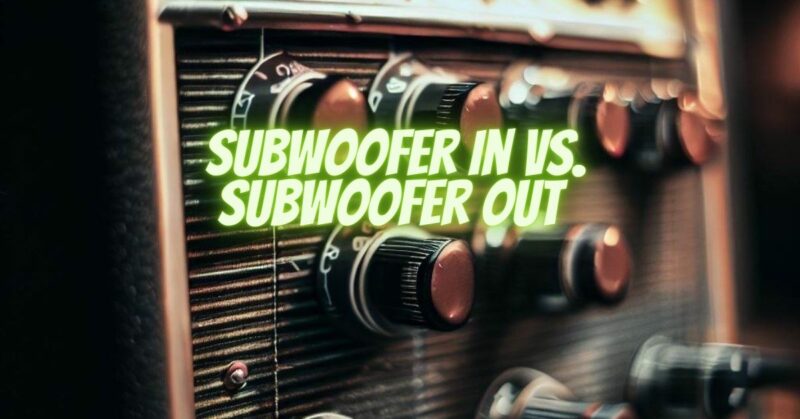In the realm of audio systems, understanding the various connections and jargon can be a bit overwhelming, especially for those new to the world of amplifiers and subwoofers. Two common terms you may encounter are “Subwoofer In” and “Subwoofer Out.” In this article, we’ll explore the differences between these two connections on an amplifier and how they relate to integrating subwoofers into your audio setup.
Subwoofer In
“Subwoofer In” refers to an input on an amplifier that is specifically designed to receive signals that are pre-filtered or pre-amplified for a subwoofer. This input is typically used when the audio source, such as a preamplifier or AV receiver, has a dedicated subwoofer output or when the subwoofer signal has been processed separately.
Key Points
- Pre-Filtered Signal: The signal entering the “Subwoofer In” connection has usually been filtered to include only the frequencies relevant to the subwoofer. This ensures that the subwoofer receives the low-frequency content it’s designed to reproduce.
- Dedicated Subwoofer Output: Audio sources with dedicated subwoofer outputs, like AV receivers, often have pre-filtered signals that can be directly connected to the “Subwoofer In” on an amplifier.
- Integration into Audio System: The “Subwoofer In” connection is a straightforward way to integrate a subwoofer into a larger audio system without additional signal processing.
Subwoofer Out
“Subwoofer Out,” on the other hand, refers to an output on an amplifier or audio source that sends a full-range signal to a subwoofer. This connection is often used when the subwoofer has its own internal crossover and amplifier or when the audio source does not have a dedicated subwoofer output.
Key Points
- Full-Range Signal: The signal sent through the “Subwoofer Out” is not pre-filtered for low frequencies. Instead, it includes the full audio spectrum, allowing the subwoofer to handle its own frequency filtering.
- May Require Additional Processing: Subwoofers connected to a “Subwoofer Out” may need additional processing, such as an external crossover or the built-in crossover of the subwoofer itself, to ensure it only reproduces the desired low-frequency range.
- Useful for Passive Subwoofers: If you have a passive subwoofer without its own built-in amplifier or crossover, connecting it to a “Subwoofer Out” may be suitable, provided you have the necessary external processing equipment.
Choosing the Right Connection
The choice between “Subwoofer In” and “Subwoofer Out” depends on the characteristics of your subwoofer, the capabilities of your audio source, and your overall audio system setup.
- Dedicated Subwoofer Output: If your audio source, like an AV receiver, has a dedicated subwoofer output that is pre-filtered, using the “Subwoofer In” connection is a straightforward choice.
- Passive Subwoofer: If you have a passive subwoofer without its own internal amplifier or crossover, connecting it to a “Subwoofer Out” may be suitable, provided you have the necessary external processing equipment.
- Full-Range Subwoofer: If your subwoofer has its own internal amplifier and crossover, and you want it to handle the full audio spectrum, connecting it to a “Subwoofer Out” allows for greater flexibility.
Conclusion
Understanding the distinctions between “Subwoofer In” and “Subwoofer Out” connections is vital for configuring your audio system properly. Whether you’re integrating a subwoofer into a dedicated home theater setup or enhancing the bass response in a stereo system, choosing the right connection ensures that your subwoofer operates in harmony with the rest of your audio components. Always consult the user manuals of your amplifier, subwoofer, and audio source for specific guidelines and recommendations related to these connections.


